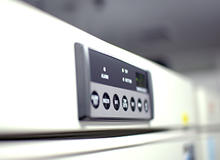
Our brain is composed of the neurons playing a central role in various brain functions and the glial cells that surround them. Glial cells consist of several cell types with differing characteristics. Astrocytes are the most abundant of the glial cell types found in the brain, and yet their role in brain function and pathogenesis is still largely unknown. Our team is focused on further analysis of astrocytes with the aim of developing novel therapeutic concepts based on a deeper, more nuanced understanding of their relation to pathogenesis mechanisms in neuronal disorders.
We are also actively working to develop novel technologies that utilize mouse embryonic stem (ES) and induced pluripotent stem (iPS) cells. Neurons are extremely diverse and cannot proliferate; it is not easy to establish in vitro disease models involving specific neuronal subtypes. Both ES and iPS cells have the potential to differentiate into any cell type found in the body, meaning they could provide us with the technology to obtain a large number of rarer, more specific neuronal subtypes. This would in turn enable drug discovery research to be conducted on neuronal disorders involving these neuronal subtypes. In this light, our team is currently promoting research into the development of novel therapeutic concepts and next-generation drugs based on innovative applications of the above concepts and technologies.









